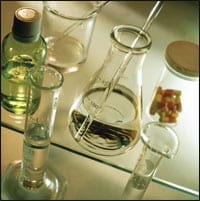 |
The skin care industry is going through a renaissance. Products have appeared in the physician’s office that can clear up skin disorders, remove age spots, and provide a mild to serious arsenal to help “slow down” the patient’s aging process.
The revolution in skin care products is not only driven by the highly touted “new wave” of “natural and/or “organic”—read, chemical-free—ingredients. It is pushed by advancements in combining new and old ingredients in effective ways.
In terms of product development, new (or reformulated) products go far beyond the capabilities of those from even a few years ago. This genre of product includes skin tighteners, antiaging creams, and wrinkle removers.
To zero in on what is happening in the industry, PSP spoke with Alison Adams-Woodford, senior research, development and editorial strategist at PCA SKIN, Scottsdale, Ariz; and Bill Kling, president and cofounder of Swiss-American Products, Carrollton, Tex.
 |
| Alison Adams-Woodford |
In terms of science/chemistry, what happened to cause this sea change?
Alison Adams-Woodford: The innovations we are seeing in the industry are not a result of one isolated change. It is a combination of a deeper understanding of skin conditions and their causes paired with advancements in peptide, raw material, and delivery-system technology.
Many concepts that are now at the forefront are actually not new, but reinvigorated. One example is MMPi ingredients. The matrix metalloproteinase enzymes in the skin are activated by sunlight, free radicals, and other negative environmental factors.
MMPi, or matrix metalloproteinase inhibitors, are many ingredients that have long been included in well-formulated topical products, but are now just getting a new look through marketing campaigns and new language.
Bill Kling: Two changes are driving the focus of more “performance” from skin care products.
 |
| Bill Kling |
One is the demand of aging Baby Boomers who have lots of problems to “fix” after years of sun damage, plus the natural aging process.
The second is the development in the last 5 to 10 years of many more skin care “tools” for fixing problems. In the past, the products were pretty much limited to glycolic acids, Retin-A, ascorbic acid, and hydroquinone. Now there are all kinds of peptides with differing purposes and varying levels of success.
Please describe what you think is new knowledge of the structure and function of the skin, and new approaches to treatment that have been redefining what is possible in antiaging skin care.
Adams-Woodford: The skin care or skin health industry has evolved in its research, development, and treatment approaches. We are developing a deeper understanding of not only specific functions of the skin—like the process of how and why melanin is deposited in the skin—but also how all the many intricate processes are interconnected within the skin.
This interconnectedness has led to the development of products that address either one specific condition or disease from many angles, or address multiple conditions simultaneously.
From a technology perspective, there are new encapsulation and delivery systems that not only keep inherently unstable ingredients stable for longer (such as retinol), but also allow previously incompatible ingredients to exist within the same formulation together.
Delivery technology also allows topically stimulating ingredients to be applied with less irritation, and to be released over time to provide for deeper penetration for dermal benefits.
Kling: There is more knowledge related to inflammation as a core driver of irritation and aging.
At Swiss-American, we are doing much more with enzymes to stop the inflammation and, where possible, reverse the aging (that is, AK damage).
Of course, broad-spectrum UVB/UVA sunscreen protection will always be key, since an “ounce of prevention is worth a pound of cure.” In addition, it is much faster and easier to prevent sun damage than it is to “cure” it.
What are some of the ingredients and compounds that have fueled the “new wave” of skin care products?
Adams-Woodford: Peptides certainly are at the head of this wave. These bioengineered chains of amino acids perform specific functions in the skin based on their structure. Some inhibit muscle contractions, others increase collagen deposition, while others function as antibacterial agents.
Another interesting wave is that of growth factors and cytokines. Many companies are claiming to be using stem cell technology. This is exciting technology but truly in its infancy. These types of ingredients are surrounded mostly with marketing, not science. There are a few companies that have done the diligence, but there certainly needs to be more research and double-blinded studies to confirm each component’s efficacy.
Kling: Peptides have been a “big deal” for the last few years to boost collagen production. Also, there are more plant extract ingredients with big promises, although the performance can vary dramatically.
How difficult is it to formulate products that look, feel, and smell like a traditional cosmetic product, but without the chemicals?
Adams-Woodford: This is a tough question that winds up resting quite a bit on semantics. The word “chemical” has come to mean something bad, while really all elements in chemistry are considered chemical elements.
Also, confusion arises when we talk about organic ingredients. Anything that contains carbon is considered organic. Not, of course, in the pesticide-free context but by classification.
Also, the thought that everything that is synthetic is somehow bad and ineffective is also false. Synthetically engineering an ingredient can often allow you to avoid using ingredients from unappealing sources. One example is Hyaluronic acid. So-called naturally sourced Hyaluronic acid comes from places like the combs of roosters. Synthetically engineered HA has the same beneficial effects but is not animal derived.
Ingredients that are good to avoid when creating gentle and effective products are synthetic fragrances and colors. These are known sensitizers and can wreak havoc in sensitive skin.
Kling: If we are talking about “free of chemicals” meaning avoiding certain chemicals, such as parabens or formaldehyde-donors, then it is not a problem. Since everything is made of chemicals in the end, many of the “natural” ingredients are really chemicals in disguise.
To make products which are truly natural and certified organic increases the cost and does require trade-offs for performance and skin feel for many categories. That is why many “natural” and “organic” claims are more marketing than true substance.
When you create a product based on organic or natural ingredients, what standards do you follow?
Adams-Woodford: Based on my previous answer, we do not conform to the “natural” or “organic” discussion going on in the industry. Many ingredients are “natural,” like petroleum, that we wouldn’t want in skin care products. Gentle and effective are most important.
Kling: We use certified-organic ingredients when requested, but otherwise we do not make “natural” claims.
There are relatively few skin care products that are genuinely organic and free from synthetic preservatives. How do you optimize the stability and shelf life of the natural or organic ingredients?
Adams-Woodford: It is true that most of the products that tout themselves as natural or organic truly are not. Some use one organically grown ingredient and then put “organic” on the label. Preservative systems are typically in a formula at very low levels and simply allow the product to have a shelf life.
There are botanicals that exert antibacterial action that allow a product to stay stable longer, but they would likely not hold up for the long term if a product were compromised by people’s daily use habits—like using their fingers to remove product from jars.
Kling: It is very important to focus on both the “water” as well as the “oil” phase to get pleasing structure and stability. You can’t count on strong emulsifiers in the oil phase doing all the work. Low pH is also important to help natural preservatives.
What is needed at the regulatory level to ensure consistent quality in new skin care lines?
Adams-Woodford: Regulation is a big topic. We actually welcome more regulation in the skin care industry, as there are many companies making false claims; comparing cosmetics to approved drug products.
As a consumer, it is very difficult to sort the fact from the fiction and, as a result, there is a great sense of fatigue and cynicism in response to advertising and marketing.
|
See also “The Greening of Skin Care Products” by Wendy Lewis in the April 2008 issue of PSP. |
There is certainly a gray area between cosmetic products and highly technical new products that are not drugs.
How regulation should move forward is unclear, but physicians and patients alike should always look for substantiation of claims.
Ask for before-and-after photographs documenting results and reputable studies that support claims. The innovations that are on the horizon are certainly very exciting.
Kling: I’m not sure we need more regulation, but I would like to see the FDA enforce claims on a uniform basis.
We see lots of variance allowed in “healing” claims, as well as other types of claims.
Shannon Triplett Leade is a contributing writer for PSP. She can be reached at [email protected].




